How the US is Transforming Pilot Training with Cutting-Edge Software | Revolutionizing the Skies
 18 January 2024
18 January 2024? Listen to the Summary of this article in Audio
The pursuit of excellence in aviation technology has profoundly impacted the landscape of pilot training software development across the United States. Standout companies like CAE are redefining how aviators are educated, from nascent beginners to seasoned professionals, through sophisticated flight training software solutions. CAE’s offerings encompass a variety of technologically advanced systems, from interactive digital courseware to world-class simulators that mirror the complex dynamics of real-world flying scenarios.
As the aviation industry continues to leverage cutting-edge advancements, aviation software development has taken a front seat, ensuring pilots are equipped with critical knowledge and practical experience through a variety of platforms. Whether preparing military personnel on specialized aircraft or shaping the skills of future commercial pilots, the U.S. holds a critical role in advancing United States aviation technology, setting precedents for global aeronautical instruction.
Key Takeaways
- Unparalleled progress in pilot training software development.
- CAE leads with innovative flight training software and simulators.
- Aircraft and crew readiness enhanced through advanced aviation software.
- Integral role of the U.S. in global aviation technology advancement.
- The strategic importance of simulation in pilot skill development.
The Evolution of Pilot Training: From Cockpit to Computer
The evolution of pilot training tells the story of an industry in constant pursuit of safety, efficiency, and technological prowess. Once relying solely on cockpit training, pilot preparation has taken a significant leap into the future with the adoption of computer-based aviation training. This transformation has been underpinned by the relentless progress in flight simulation software development, which has not only redefined the parameters of pilot education but also the very fabric of aviation learning environments.
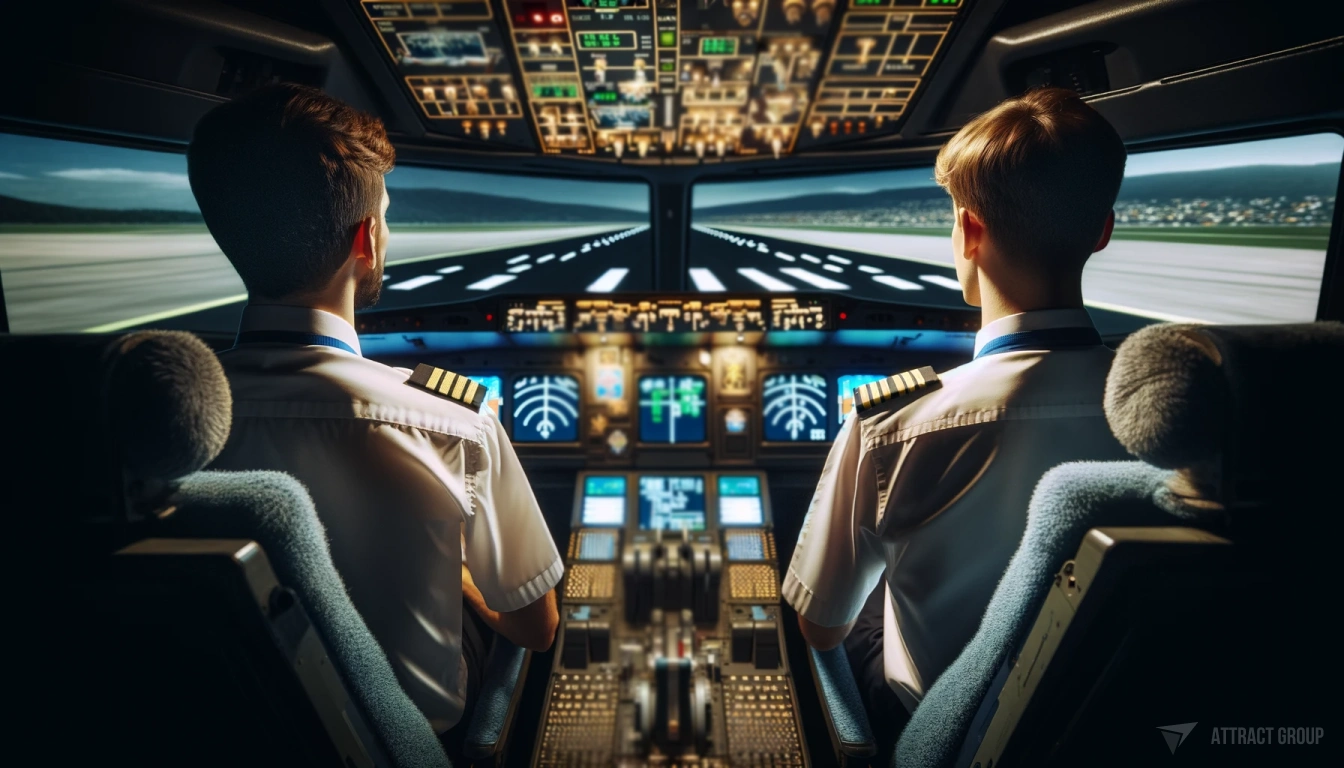
Simulation technology, once a novel idea, has become the cornerstone of modern pilot training programs. The integration of sophisticated computer algorithms and intricate modeling has afforded the industry an ability to replicate real-life flight experiences within the confines of a controlled space. This approach to training provides pilots with the invaluable opportunity to hone their skills without the risks associated with actual flight.
Let’s explore how this remarkable shift from traditional methods to advanced simulations has impacted the industry:
- A surge in technological adoption has seen the replacement of analog cockpits with advanced computer-based simulators.
- Emphasis on analytics and adaptive learning methods has resulted in personalized training experiences.
- Significant cost reductions and improved safety protocols are a direct consequence of this shift.
- The scalability of simulation-based training has greatly increased accessibility to pilot education.
The table below offers a glance at the contrast between traditional cockpit training and current computer-based aviation training approaches:
| Training Type | Training Methodology | Advantages |
|---|---|---|
| Cockpit Training | Hands-on, in-aircraft instruction. | Real-world experience; tactile feedback. |
| Computer-Based Aviation Training | Simulation software; virtual scenarios. | Safe learning environment; reduced costs; data-driven insights. |
| Hybrid Training | Combination of in-aircraft and simulation. | Balanced real-world and simulation experience; comprehensive skill development. |
As we witness the ongoing evolution of pilot training, it’s clear that the era of computer-based aviation training promises to furnish pilots with comprehensive skillsets, prepping them for the complexities of modern airspace. The exponential growth in flight simulation software development not only cements the pivotal role of such technologies in shaping the pilots of tomorrow but also demonstrates an unwavering dedication to elevating aviation standards on a global scale.
Key Components of Advanced Pilot Software Solutions
The realm of aviation training is witnessing a paradigm shift, heralded by the advent of advanced pilot software solutions. These solutions are the keystones supporting a new era of pilot training that prioritizes adaptability, precision, and an enriched learning experience. At the forefront of this shift are realistic flight simulation, virtual reality pilot training, and the incorporation of data analytics and machine learning into the fabric of pilot training program development.
Realistic Flight Simulation for Better Skill Retention
As pilot software solutions become more sophisticated, the fidelity of flight simulator development stands as a testament to the industry’s commitment to realism and skill acquisition. Companies like CAE are pushing the boundaries of simulation with their high-fidelity full-mission simulators, designed to provide aviators with scenarios so true to life that the skill transfer from virtual to actual flight is seamless. The efficacy of these simulators in skill retention is unparalleled, offering a diversity of experiences that sharpen a pilot’s capabilities under varied conditions.
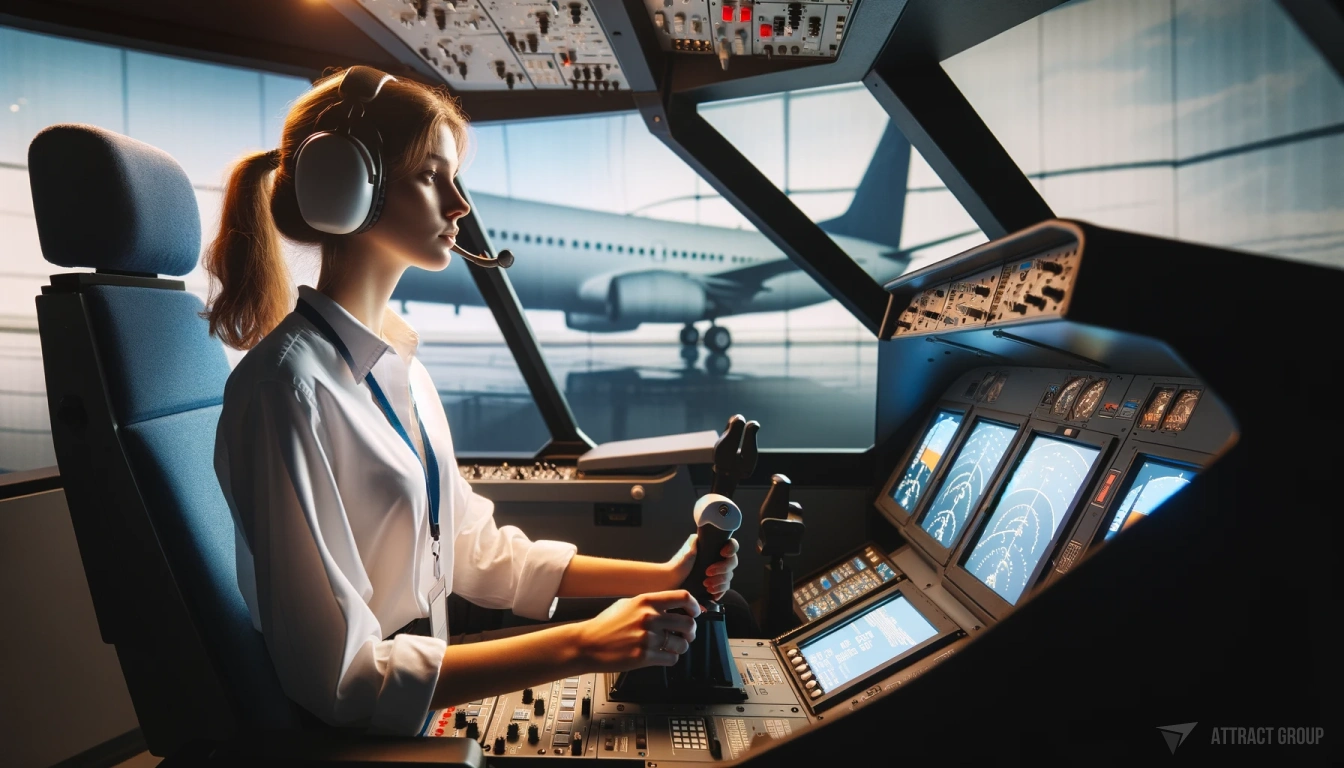
Integrating Virtual Reality for Immersive Learning Experiences
The utilization of virtual reality (VR) in pilot training has revolutionized immersive learning experiences, allowing pilots to immerse completely in virtual environments. Such technology enables simulations that encompass a 360-degree view of the cockpit, accurate aircraft responses, and multi-sensory feedback, thus giving rise to a more intense and focused learning habitat.
Leverage our expertise in building innovative pilot training solutions, from immersive simulations to adaptive learning platforms.
Data Analytics and Machine Learning to Personalize Training
The integration of data analytics in aviation enables a profound understanding of pilot performance, which is crucial for tailoring training programs. Machine learning in pilot training further capitalizes on data to adjust scenarios and challenges to match the skill level and learning speed of the individual pilot. These personalized pilot training solutions mean that every pilot can experience a training regime that is not only rigorous but also meticulously crafted to meet their unique needs and bolster their career trajectory.
Data-driven insights and predictive models inform the design and iteration of training modules, ensuring a continuous improvement loop that aligns with the evolving landscapes of aviation technology and regulation.
- Greater engagement through repeatable and variable scenarios
- Enhanced safety with risk-free training environments
- Streamlined progress tracking with data analytics
With these core components now deeply embedded into pilot training infrastructures, the path to creating competent and confident aviators has never been clearer. The aerospace sector is thus positioned to soar towards new horizons of efficiency and expertise in pilot training.
The Role of Custom Aviation Training Software in Skill Development
In the high-stakes realm of aviation, skill development for both new and experienced pilots is paramount for ensuring safety, efficiency, and a high standard of operational performance. Custom aviation training software has emerged as a critical driver of tailored educational experiences, enabling a multitude of learning pathways that are specific to the needs of aviators and their respective flying machines. The development and deployment of such advanced aircraft pilot training tools represent a significant leap towards achieving exceptional proficiency in various areas of a pilot’s career.
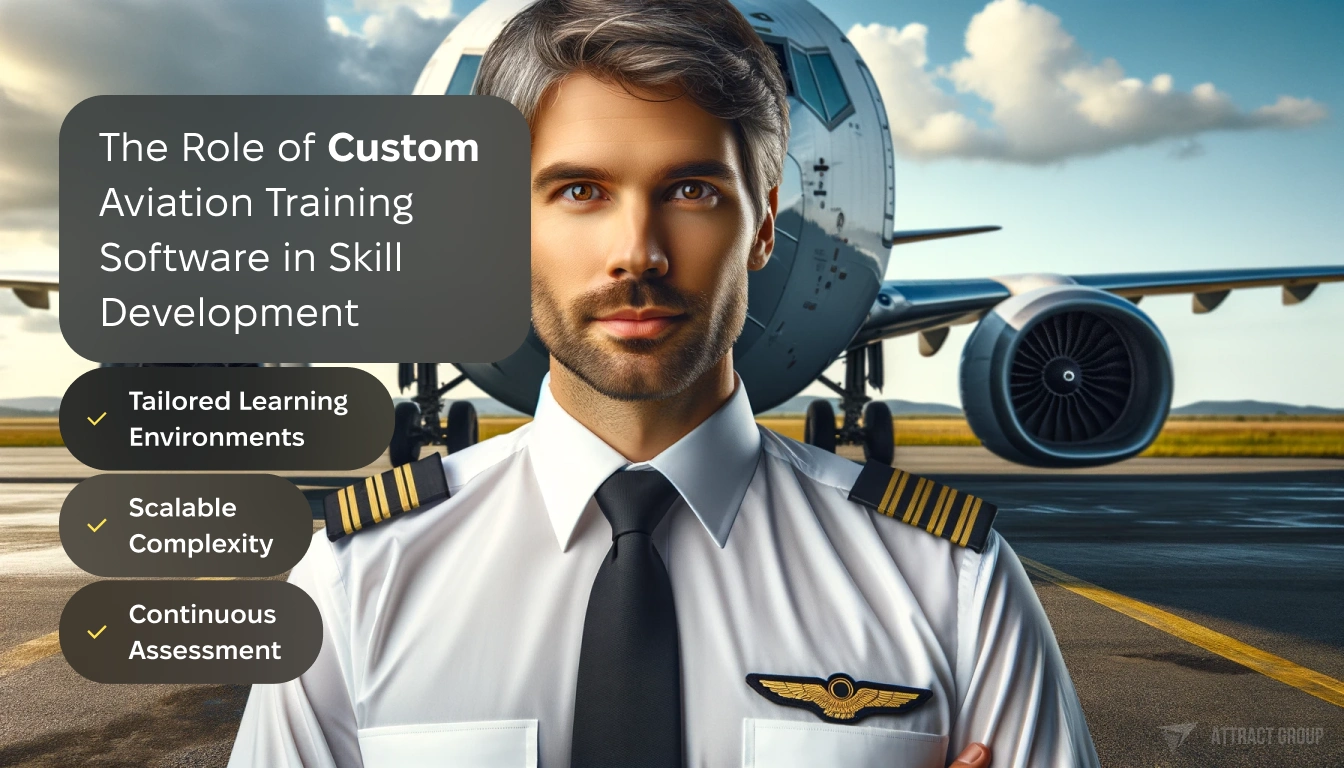
This software provides a myriad of scenarios that mimic real-life challenges pilots may face, ensuring that trainees are well-prepared for the unexpected. Below, we outline the three essential aspects of how custom aviation training software facilitates skill development in aviation.
- Tailored Learning Environments: The software provides a diverse range of situational scenarios for pilots, ensuring that individuals receive a customized learning experience that targets specific skill gaps and learning objectives.
- Scalable Complexity: As pilots progress, the software can introduce more complex scenarios, thus enabling a continuous learning trajectory that advances a pilot’s capacity to handle challenging situations.
- Continuous Assessment: Real-time feedback mechanisms integrated within the training software allow instructors and trainees to gauge performance, address weaknesses, and track improvements over time.
To illustrate the versatility of custom aviation training software, we present a detailed comparison of the different types of tools and aspects they enhance in a pilot’s training regimen.
| Training Tool Type | Learning Aspect | Brief Description |
|---|---|---|
| Flight Simulators | Instrument Proficiency | Simulators employ advanced graphics and physics engines to replicate cockpit instruments and flight dynamics, fostering a deep understanding of aircraft operation. |
| Virtual Reality (VR) Systems | Environmental Awareness | VR systems immerse pilots in 360-degree virtual environments, enabling them to develop situational awareness and strategic thinking in a safe setting. |
| Desktop Trainers | Procedure Memorization | Designed for ground use, desktop trainers help pilots memorize standard operating procedures and emergency protocols without aircraft usage. |
| Learning Management Systems (LMS) | Theoretical Knowledge | LMS platforms provide a structured sequence of theoretical lessons and tests which are crucial for building a solid foundation in aviation principles. |
| Analytic & Debriefing Tools | Performance Analysis | These tools analyze a pilot’s decisions and maneuvers during training sessions, providing valuable insights for debriefings and skill refinement. |
As the landscape of aviation continues to evolve, so does the complexity and functionality of custom aviation training software. These advanced training tools not only fortify the knowledge base of pilots but also engage them in a process of continual learning and adaptation. In essence, this software is a linchpin in the pursuit to achieve higher standards of aeronautical expertise and operational safety.
Our team can develop tailored aviation training solutions to address your specific educational needs and take pilot proficiency to new heights.
Pioneers in US Aviation Software: A Look at Industry Leaders
The aviation landscape is continually evolving, driven by technological innovation and the ceaseless quest for enhanced pilot proficiency. Standing at the forefront of this progression are US aviation software pioneers who have taken up the mantle of revolutionizing how pilots are trained. Among them, CAE emerges as a key player, renowned for their cutting-edge CAE next-generation training systems and profound contributions to advanced pilot training.
CAE’s Contribution to Next-Generation Training Systems
CAE’s reputation as a leader in the field of pilot training is well-earned, with the Canadian company’s extensive footprint in the US aviation software industry setting the standard for immersive, realistic training environments. Their innovative approach extends beyond mere simulation — CAE’s arsenal includes a spectrum of tools from digitally-enabled courseware for theoretical learning, to desktop trainers for procedural practice, to the pinnacle of realism in full-mission simulators.
The sophistication of CAE’s training systems underscores the critical elements required to prepare pilots for the demands of modern aviation. With an emphasis on real-world application, their training solutions offer a blend of live-virtual-constructive (LVC) capabilities, ensuring an immersive experience that closely mimics actual operations.
CAE has strategically positioned itself to support not just the commercial and civilian sectors but also to meet the rigorous demands of military and defense training. The breadth of their offerings addresses the entire aircrew, including pilot, sensor operators, and maintenance crew—delivering comprehensive training that reinforces mission readiness.
- Integration of higher fidelity in simulators for unparalleled realism
- Multi-faceted training platforms for complete aircrew readiness
- Digital solutions for ground forces and public safety training
To truly gauge the impact of CAE’s advanced training systems, a comparison below delineates their suite of training solutions against traditional methods:
| Training Method | Description | Benefits |
|---|---|---|
| Digital Courseware | Interactive theory-based learning modules | Accessible, engaging, and up-to-date educational content |
| Desktop Trainers | Ground-based procedural trainers | Cost-effective means for systematic practice |
| Full-Mission Simulators | High-fidelity simulators providing real-world scenarios | Exposure to complex flight conditions in a risk-free environment |
| LVC Training | Systems that integrate live, virtual, and constructive platforms | Enhanced realism for dynamic, mission-specific training |
CAE’s expansive reach and deep investment in next-generation training represent not just a mere evolution but rather a redefinition of the parameters in pilot preparation. Their steadfast commitment to advancing pilot training continues to solidify their role as an indispensable resource the world over, echoing the innovation and prowess characterizing US aviation software pioneers.
“Our mission is to make every flight simulation experience as close to reality as possible, and help ensure pilots are mission-ready.” – CAE Statement on the goal of their advanced pilot training systems.
CAE’s position at the helm of aviation training innovation heralds a future where aircrews are not only trained but are truly sculpted to face the challenges of contemporary flight, from domestic aviation to the complexities of global theatres of operation.
Partner with our team of experts to develop revolutionary aviation training solutions that leverage the latest technological advancements.
Aviation’s Technological Renaissance: New Tools and Techniques
The aviation technological renaissance we are currently experiencing is nothing short of groundbreaking. It signals an era where new aviation tools and advanced pilot techniques are transforming the industry at an unprecedented pace. This blossoming of aviation software innovation is not merely a trend but a fundamental shift in the aviation paradigm, driving pilots and training programs toward excellence and greater heights of capability.
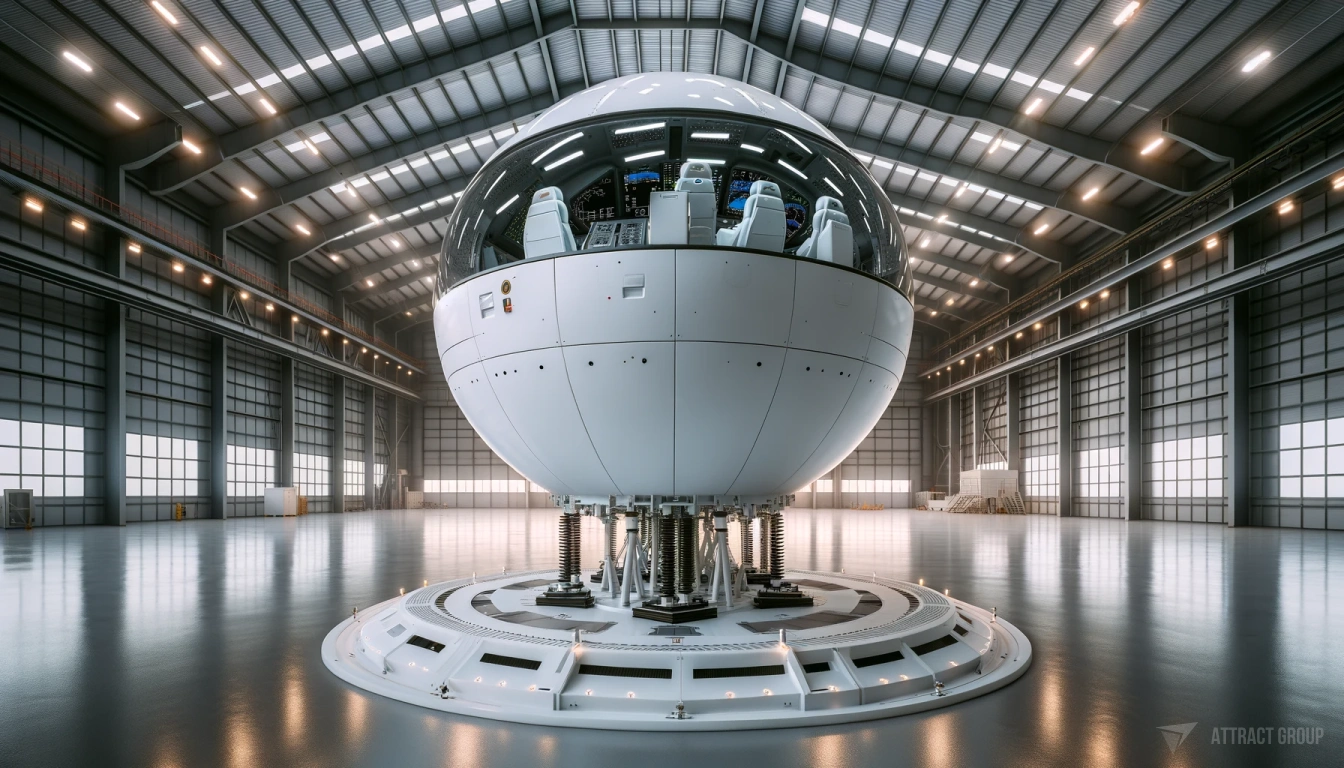
At the heart of this renaissance are key developments that combine the latest technological advances with a deep understanding of aviation necessities. These innovations cover a wide spectrum, from new flight simulation technologies to enhanced pilot assistance systems, each designed to provide pilots with a more intuitive and comprehensive training experience.
- Emergence of machine learning algorithms to personalize pilot training and adapt scenarios in real-time
- Advancements in augmented reality (AR) that provide pilots with immersive, interactive training applications
- Introduction of advanced flight management systems that streamline procedures and cockpit management
Let’s delve deeper into a few groundbreaking tools reshaping the way pilots navigate the skies:
- Adaptive Learning Platforms: These platforms monitor pilot performance and adjust training modules to challenge and support the learner effectively.
- Next-Gen Flight Simulators: Offering lifelike cockpit replicas and environmental factors, simulators are ever-closer to the realities of flight.
- Smart Glasses for AR: Wearable devices that overlay critical information onto the real world, enabling pilots to train with a hands-on approach in a variety of settings.
This revolution is marked by a collective stride towards a future where pilot training is deeply interwoven with technology, mirroring the complexity and demands of contemporary flight operations. Accordingly, the table below examines some of the innovative tools against the backdrop of pilot skill development:
| Technological Tool | Area of Pilot Technique Enhancement | Specific Benefit |
|---|---|---|
| Smart Aviation Glasses | Spatial Orientation | Enables pilots to train in 3D environments, improving their spatial awareness and response times. |
| Artificial Intelligence (AI) Co-Pilots | Decision Making | Provides assistance and recommendations, allowing pilots to practice critical thinking and decision-making skills. |
| Advanced Analytics Dashboard | Performance Tracking | Gives instructors data-driven insights on pilot progress, enabling targeted improvements and the tracking of skill acquisition. |
“Our industry is on the cusp of a new era where pilots are empowered with intelligent tools and comprehensive insights akin to having a digital co-pilot—an extension of their capabilities.” – Comment on the future of aviation training tools.
The impact of these advancements extends beyond the cockpit, as the education and upkeep of pilot skills become a seamlessly integrated journey with these technologies at their core. The trajectory is set for a future where pilots are prepared for anything the skies may hold, with aviation technological renaissance paving the runway for their takeoff.
Maximizing Training Efficiency with Modular Pilot Software Solutions
The aviation sector is experiencing a revolutionary shift in the way pilots are trained, primarily through the integration of modular pilot software solutions. These innovative platforms are reshaping the education landscape by focusing on maximizing training efficiency and offering flexible learning solutions. With a premium on customizability and scalability, modular software systems are rapidly becoming the cornerstone of effective pilot training across a variety of aviation institutions.
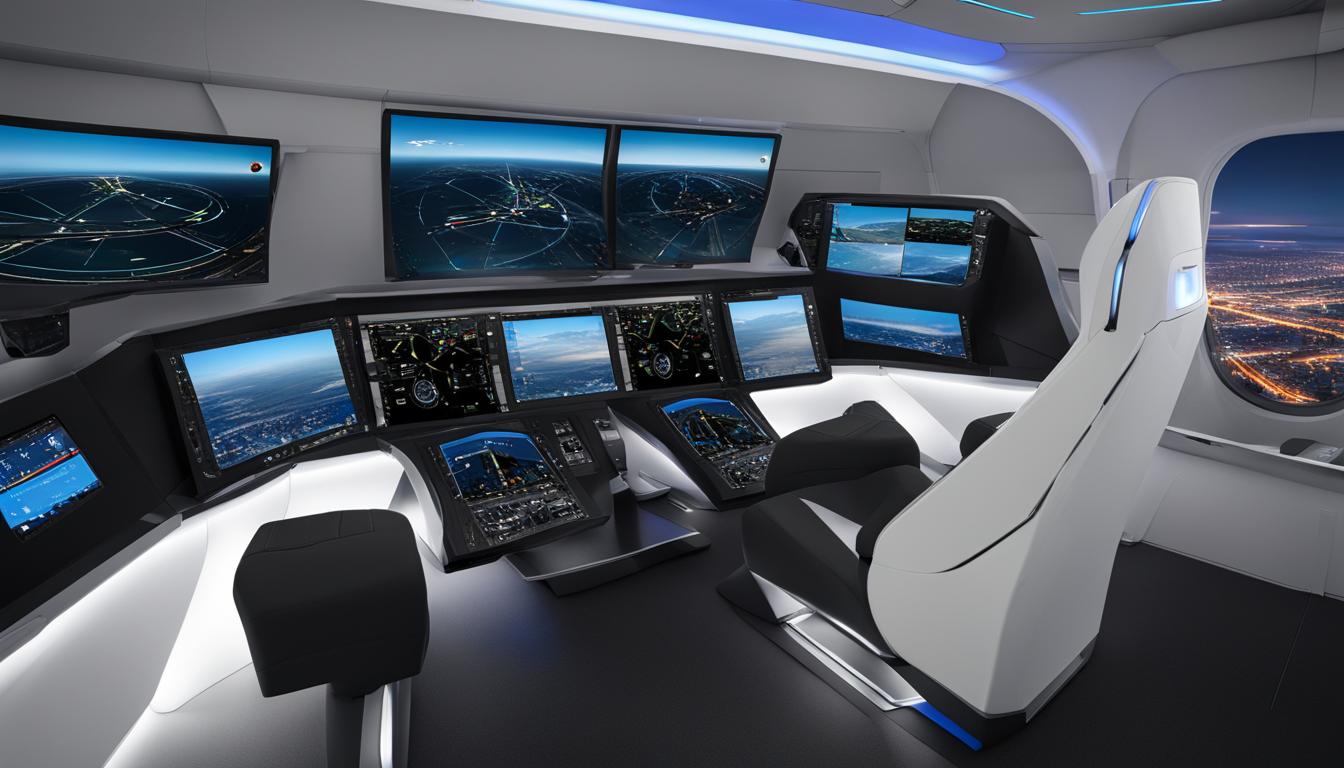
By implementing modular systems, training programs can cater to individual learning styles and proficiency levels, enabling more targeted and efficient training approaches. The emphasis on adaptability ensures that these software solutions can flexibly integrate new technologies and methodologies, keeping pace with the evolving demands of the aviation industry.
“Modular training is a game-changer, creating environments where pilots can flourish by engaging with materials that adapt to their unique needs and progress.” – Industry Expert on Pilot Training Innovation
The compelling benefits of modular software solutions in the field of aviation training are evidenced by their capacity to streamline resource allocation while simultaneously enhancing learning outcomes. Let’s explore the tangible advantages that modular software brings to the frontline of pilot training.
- Customized Learning Pathways: Each pilot has access to a tailored suite of modules that align with their specific training requirements, promoting a more individualized learning experience.
- Scalable Training Content: Institutions can effortlessly scale training operations up or down, depending upon demands, without compromising the quality or continuity of the training.
- Cost-effective Resource Use: Enhanced efficiency in training delivery allows for optimal use of both instructors’ expertise and organizational funds.
To illustrate the efficacy of modular software in training environments, the table below provides a comparison of modular versus traditional training methods from the perspective of resource optimization and learner engagement.
| Training Method | Resource Optimization | Learner Engagement |
|---|---|---|
| Traditional Training | Fixed resources, one-size-fits-all approach | Passive absorption, limited by general content |
| Modular Software Solutions | Dynamic resource allocation, adaptable content | Active participation, personalized learning experience |
| Blended Approach | Combines fixed and dynamic resources effectively | Integrates passive and active learning for a well-rounded experience |
In an industry as critical as aviation, where the margin for error is negligible, the stakes are incredibly high. Modular pilot software solutions represent an essential evolution in training techniques, equipping tomorrow’s pilots with the robust skill set required for safe and efficient flight operations. As aviation technology advances, modular training systems stand poised to revolutionize not just how we teach, but also how pilots best learn and engage with the material, marking a new era of smarter, more responsive pilot education.
Breaking New Ground: The Future of Flight Training Software Development
The inexorable march towards technological innovation within the world of aviation continues to set new standards in pilot training. The development of training software is at the vanguard of this movement, promising a future replete with advancements previously unimagined. The future of flight training software is poised to be transformative, leveraging the power of progress to engender a sea change in how pilots learn, train, and excel.
As we stand on the cusp of what may well be described as a revolution, it is clear that the union of artificial intelligence (AI), virtual reality (VR), and data analytics is charting new territories in aviation training software. This trio of disruptors will redefine educational paradigms, creating more efficient, immersive, and personalized training experiences. Let’s embark on a journey through the prospective vistas of flight training software, where innovation knows no bounds.
“The advent of AI and VR in aviation is not just an incremental step forward; it’s a giant leap towards creating a training environment indistinguishable from reality.”
- Artificial Intelligence: A lynchpin in the future of training software, AI’s adaptive learning algorithms are setting the stage to customize training modules to the aptitude and progress of each individual learner.
- Virtual Reality: By breaking new ground in aviation, VR enhances the efficacy of simulated environments, providing an unprecedented level of immersion that dramatically boosts skill acquisition and memory retention.
- Data Analytics: The analysis of training performance data promises to drive the continuous enhancement of pilot training programs, ensuring that they remain at the leading edge of efficacy and relevance.
Consequently, we anticipate a landscape where the development of training software is increasingly synchronized with a pilot’s career progression, providing a customized and comprehensive pathway from novice to expert aviator.
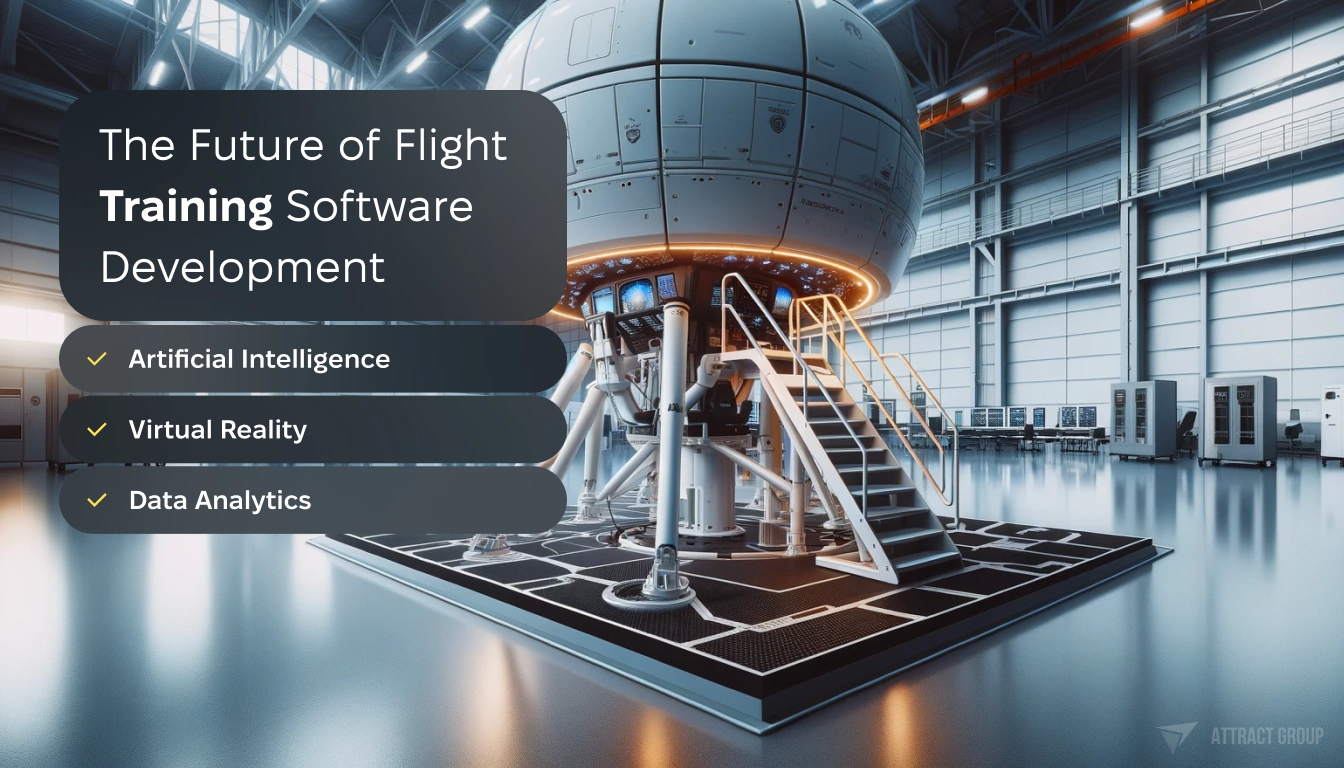
Technological Synergy: The Integration of AI, VR, and Big Data
Envisioning the trajectory ahead, the confluence of AI, VR, and Big Data stands out as the tripartite core of a new training ecosystem:
- The harnessing of AI for predictive modeling and personalized learning plans that adapt in real-time to a pilot’s performance.
- VR’s deepening role in creating simulated cockpits, where every switch, gauge, and control is mapped with precision, allowing for authentic practice without the risk.
- Deployment of data analytics to distill training insights, providing an empirical base to refine training programs continually.
A peek into this bright future is offered by the table below, spotlighting how each technology contributes to the refined art of flight training:
| Technology | Impact on Training | Expected Advancements |
|---|---|---|
| Artificial Intelligence (AI) | Customized learning experiences | AI coaches providing real-time feedback and scenario adaptation |
| Virtual Reality (VR) | Enhanced simulation fidelity | Full-immersion cockpit environments and tactile feedback systems |
| Data Analytics | Targeted training improvements | Granular analysis of pilot performance leading to personalized curriculum development |
We are entering an epoch where every facet of training, from theoretical knowledge to emergency response, is amplified by software that learns, adapts, and evolves to meet the ever-increasing demands of aviation. This synergy—a blend of human expertise and machine intelligence—foretells a future where breaking new ground in aviation is not just a slogan, but a tangible, lived reality for pilots and trainers alike.
“We are standing on the runway to the future, where the digital and the real are seamlessly integrated, promising safer skies and finely honed aviator skills.”
United’s Aviate Program: Innovating Pilot Career Development
Embarking on a journey to become an airline pilot is no small endeavor; it requires dedication, discipline, and a clear path to success. The United aviate program has emerged as a beacon for those aspiring to reach new heights in their aviation careers, presenting a comprehensive route to becoming a United Airlines pilot. Known for its innovative approach to pilot career development, the program is structured to support pilots every step of the way.

United Airlines is committed to training tomorrow’s pilots through an array of tailored experiences designed to propel participants toward their goals. The aviate training philosophy is grounded in an inclusive culture, with a focus on individual growth and mentorship provided by experienced United pilots. The Aviate program not only provides participants with a clearly defined route to becoming a first officer but also enhances their journey with extensive industry connections and resources.
Enhancing Pilot Career Paths with the Aviate Program
The United aviate program is a testament to United Airlines’ commitment to airline pilot path enhancement. It represents a shift in pilot career planning, offering tangible benefits that extend beyond the standardized training protocols. With Aviate, participants gain not just knowledge and flight hours, but also invaluable industry insights and networking opportunities.
- Career progression to United First Officer upon program completion
- Global travel privileges across United’s extensive network
- Mentorship and coaching from seasoned United pilots
- Culture immersion through senior leadership interactions and company events
Training Tomorrow’s Pilots: Insights Into the Aviate Training Philosophy
At the core of the aviate training philosophy lies a deep-seated belief in supporting pilots as individuals. This philosophy makes United’s pilot development program astoundingly effective in fostering robust piloting skills that mesh seamlessly with the airline’s culture.
The program’s focus is on equipping pilots with not only the technical knowledge but also the interpersonal skills needed for the multifaceted demands of an airline pilot. Its success stories demonstrate the efficacy of the Aviate pathway and its role in shaping confident aviators adept at navigating the complex aviation landscape.
“Our Aviate program is setting the bar for inclusive and comprehensive pilot training, ensuring each participant has access to the very best of United’s resources and expertise to succeed.” — United Airlines’ Commitment to Pilot Development
United’s Flight Training Center in Denver reflects their dedication to cutting-edge training environments and methodologies, showcasing a facility where aspiring pilots can experience the pinnacle of aviation instruction.
| Program Component | Details | Impact |
|---|---|---|
| Mentorship Program | Guidance from experienced United pilots | Provides role models and industry insights to aspiring aviators |
| Flight Training Center | State-of-the-art facility with advanced training resources | Delivers unparalleled practical training to enhance pilot proficiency |
| Pathway to Pilot Position | Defined steps to progress from student to United First Officer | Transparent career development and expedited advancement |
| Culture and Network | Connection with United’s values and global reach | Cultivates a global perspective and company loyalty |
With the United pilot development program drawing from United’s vast knowledge pool and operational experience, participants can rest assured that their careers will take off towards promising horizons. The Aviate program exemplifies United’s pledge to not just fill the pilot seats, but to do so with exceptionally well-trained, well-rounded professionals who will lead the airline industry into the future.

Conclusion: The Summit of Aviation Training Efficacy
As this exploration of pilot training software development reaches its conclusion, a vivid portrait of aviation’s future materializes. It is one where pilot software solutions are meticulously crafted by frontrunners like CAE and initiatives such as United’s Aviate program, substantiating a future rich with skilled aviators prepared via the latest technological advancements. These entities have laid the groundwork for an era in which the development of pilot skills is transformed into an engaging, immersive, and personalized narrative; one finely tuned to each pilot’s career journey.
What emerges from these discussions is a keen anticipation for the future of pilot software solutions. It is a future that holds promises of AI-infused training modules, VR-driven simulators, and analytic tools that gauge and enhance a pilot’s readiness for the real-world complexities of flight. These advancements are set to consolidate the impact of aviation skill development, shaping an industry that prides itself on precision, safety, and efficacy. Moreover, the collaborative push of governmental bodies and aviation enterprises will continue to serve as a testament to the collective commitment to advancing pilot proficiency on a global scale.
The trajectory is thus set toward a horizon where the mastery of the skies rests on the shoulders of those who have been molded by the best that aviation training software has to offer. This canvas of innovation in pilot training software development stirs assurance that the future is bright for next-generation pilots. They are the embodiment of an aviation legacy that will continue to soar, fostered by unparalleled investment in the pursuit of excellence within the realm of pilot training.
Connect with our team to find out how custom aviation software can take your training programs to new heights.
FAQ
What does pilot training software development involve?
Pilot training software development entails creating various educational and simulation tools designed to enhance pilot training. This includes digital courseware, desktop trainers, full-mission simulators, and virtual reality experiences. Development is focused on providing realistic, scalable, and data-driven learning solutions for aviators in the United States and beyond.
How has the evolution of pilot training impacted the aviation industry?
The shift from traditional in-cockpit instruction to computer-based aviation training has revolutionized the industry. Flight simulation software development has made training safer, more cost-effective, and scalable. It has allowed pilots to experience realistic flying scenarios without the risks associated with actual flying, ultimately improving the overall quality of training.
What is the significance of realistic flight simulation in pilot training?
Realistic flight simulation is crucial for better skill retention and preparedness. High-fidelity simulators offer pilots the experience of handling a real aircraft in a variety of scenarios. This level of realism is key to ensuring pilots are well-equipped to face any situation they might encounter in the sky.
How is virtual reality used in pilot training programs?
Virtual reality (VR) technology is integrated into pilot training to provide immersive learning experiences. VR simulates a 3D environment where pilots can practice flights and procedures in a controlled yet true-to-life setting, enhancing the overall efficacy of the training process.
Why are data analytics and machine learning important in personalized pilot training solutions?
Data analytics and machine learning are utilized to tailor the training to the individual learning needs and performance of pilots. These technologies analyze performance data to identify areas of improvement, allowing for adaptive learning and more personalized training experiences.
How does custom aviation training software facilitate skill development?
Custom aviation training software provides scalable and flexible solutions that are tailored to meet the exact requirements of aviation professionals. This fosters a structured learning curve, with tools and content that advance pilots’ skills efficiently and effectively.
What is CAE’s role in next-generation training systems?
CAE is a leading figure in developing next-generation training systems, offering a comprehensive range of products for numerous military and commercial platforms. Their efforts in pushing the boundaries of flight simulation and training software remain key to their reputation as innovators in advanced pilot training.
How are new tools and techniques changing pilot training methodologies?
The aviation technological renaissance has introduced advanced tools and techniques that are reshaping how pilots are trained. Innovations in simulation, virtual reality, and analytics offer more effective ways of teaching and learning, ensuring pilots are better prepared for the demands of modern aviation.
What are modular pilot software solutions, and why are they important?
Modular pilot software solutions offer customizable and adaptable training programs that can be modified to fit varying training requirements. They are important because they allow aviation institutions to enhance training efficiency and optimize resource allocation.
What are some anticipated trends in the future of flight training software development?
Future developments in flight training software are expected to see further integration of technologies such as AI, VR, and data analytics. These advancements are likely to continue redefining the landscape of pilot training by offering more sophisticated and effective training tools.
How does the United Aviate program innovate pilot career development?
The United Aviate program provides a structured path to becoming a United Airlines pilot, offering coaching, networking, and professional development opportunities. Its innovative approach emphasizes support and inclusive culture, ensuring pilot career development aligns with industry needs and the personal growth of each aviator.
What is the Aviate training philosophy, and how does it prepare pilots for the future?
The Aviate training philosophy centers on creating a supportive environment where pilots can share knowledge and experience growth. With access to leading training resources and mentors, the program aims to prepare pilots for a successful career in aviation with a strong foundation in safety, professionalism, and leadership.









